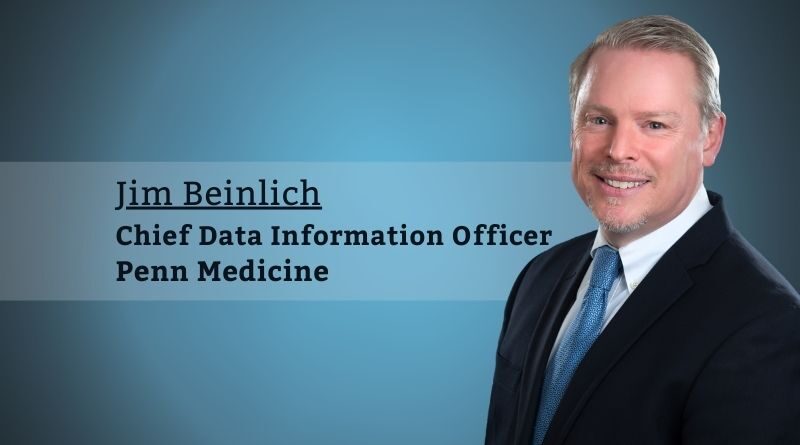The role of cloud and analytics as emerging technologies in healthcare
By Jim Beinlich, Chief Data Information Officer, Penn Medicine
Introduction
Cloud technology and analytics have been around for quite some time. Still, they are taking on lead technology roles in healthcare, especially after the past year where working “anywhere and anytime” has become a reality. According to TechNavio, the US Healthcare cloud market is expected to grow by $25 billion between 2020 and 2024 at a rate of 23% annually. What’s driving the growth appears to be the ever-increasing amount of data generated by Electronic Health Records (EHR), the amount of network-aware medical devices, and the general increasing demand for data as organizations look for more insights into performance and management.
While working at a large academic health system like Penn Medicine offers some advantage over smaller organizations that might not have the same resources, we have the same challenges with the adoption of technologies that anyone else does. Change and transformation are never easy. Here are some examples of the challenges we have faced while adopting cloud technologies and our transformation of analytics to the cloud. I’ll take the people, process, technology approach but will go in reverse order.
Technology
There are numerous platforms and products that allow you to build out a high performing analytics platform. The technology works and is widely available in traditional capital purchase and subscription-based operational expense models (more on that below).
From a data visualization perspective, it is getting harder to find the difference in tools. Whether you are a Tableau, Qlik, or PowerBI fan, the differences seem to be boiling down to cost and preference. Another benefit of some of the new cloud technology is the bundling of certain services in the cloud platform that might have been procured and licensed separately in a legacy system. A good example is the Extract, Transform, and Load (ETL) tool. As we migrate to the cloud, we are still using our legacy ETL tool, which requires separate licensing and staff to maintain. Our cloud platform has an ETL service bundled with the platform we plan to migrate to (saving money and the skillset barriers that come with having to use a separate tool).
One of the challenges I would highlight here is shifting from traditional CapEx technology purchases to OpEx purchases.
- Difficulty in forecasting future operating costs when you have yet to build out and migrate your workloads to the cloud
- Difficulty explaining the shift to IT and Finance leadership
- Period of overlapping costs as you ramp up cloud spend but are not yet able to migrate away from legacy hardware and software
You will also need to decide early on your cloud partner strategy – will you be single cloud or multi-cloud? If you are already using one of the big tech vendors for any enterprise services (Google, Microsoft), your decisions should be easier because of existing relationships. Selecting a single cloud provider offers the ability to drive bigger discounts and the benefit of dealing with a single provider for contracting and service. Others may find that a multi-cloud strategy allows you to pit vendors against each other to drive discounts. This will add complexity to the mix (contracting, services, technology, etc.). You will also need to decide if your strategy will be to use the cloud-provided services like ETL, database, etc., that allow you to take the opportunity to modernize your applications but will mean a longer timeline to migrate to the cloud. On the other hand, using containers and virtual machines to lift and shift applications will get you to the cloud quicker, but you may never circle back to modernize those applications.
Process
One of the most significant changes we have seen with our transition to the cloud is from a process perspective. While we’ve used agile principles with our legacy environment, those processes have heightened importance with the cloud. Moving changes to cloud-based analytics environments can be done with greater frequency and require less “system re-configuration.” Be prepared to be much more consistent with what you may already be doing if you already use agile principles.
Data stewardship and governance also have increased importance with more frequent enhancement to your data and analytics products. Having a well-functioning development pipeline to make constant enhancements can be disastrous without strong data governance and stewardship. Who is vetting and approving proposed changes to the data (and metrics)? Who is validating the results? If you don’t already have well-functioning data governance, my advice is to start now.
People
Everything in technology at some point comes down to process and people. Unless you are purchasing out of the box analytics solutions, there will most likely be a significant impact on your analytics staff.
- Role changes for many technical staff will present themselves as you move to the cloud due to pre-built services that can replace legacy engineering
- New roles for Database Administrators
- ETL developers shift from programming to leveraging built-in cloud services
- Skillsets shift from “engineering” to “how-to” and “where to” to support self-service
- Product owners become more critical liaisons with clinical and business communities
Looking outside of I/T, one of the foundation elements of any analytics program is governance. We were lucky that we had already been implementing data governance to oversee and lead the establishment of standard definitions for data and metrics. We have various “Data Domain Committees” let by clinical and operational leaders who take on the very tough task of getting consensus and establish standards across the organization. We have over 500 approved metrics and more to come. Here is the high-level structure of our committees. Implementing a solid governance structure ties all of the other pieces together and is the pathway to success.
| Ambulatory Operations | Hospital Operations | Quality and Safety |
| Access Scheduling Productivity | Throughput ED, Peri-op , Radiology | Mortality Complications Readmissions Safety |
| Finance | Marketing & Patient Experience | Research |
| Hospital finance Ambulatory Finance | Physicians Referrals HCAHPS | Clinical Trials Genomics Phenotypic Data |



